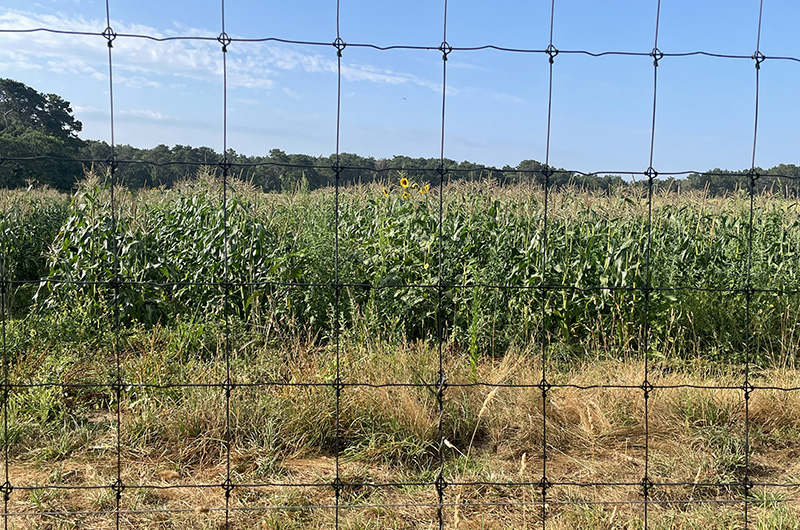To farm is to wrestle with nature, to hijack her own powerful evolutionary flow to our culinary ends. We have a head start on those crops adapted to our natural conditions, like the blueberries cultivated and now coming into ripeness on several Island farms. But corn is not one of them. How odd is it that this mutated descendant of subtropical marsh grass should end up on our Atlantic agglomeration of glacial detritus, and how much more unlikely that it actually grows?
Sweet corn, the delicate and sugar-filled cultivar that you can grill, slather with butter and eat off the cob, faces major obstacles to Vineyard cultivation. The corn earworms are relentless here; they favor coastal and sandy conditions that cover the entire Island. Sometimes they isolate themselves to the tip of an ear; sometimes they devour the entire thing. Birds, too, always take their tax.
When I visited one of the Morning Glory cornfields off Meeting House Way, blackbirds were everywhere. They flitted about the stalks, carefree, probably eating their share of next week’s harvest. The only way to mitigate for birds is to plant more corn and hope they leave some for the humans. For the worms (actually adolescent moths), there is little that can be done save pesticide.
Island Grown Initiative has noted some success from their “cornipillar,” a row-long mesh tent constructed to prevent the moths from laying eggs in the crop. It’s a compelling idea but it seems to me that such a system is unfeasible for the massive scale of sweetcorn cultivation required to meet demand each summer. I eagerly await new developments in this exciting new corn tech.
Like the squash glean last week, my visit to the cornfield reminded me of all the worst aspects of corn picking. A cornfield always amplifies the day’s heat, stalks steaming up a tropical micro-climate as wild radishes at the ends of the rows permeate a sweetly rotten scent. I couldn’t tell if it was condensation or sweat that beaded on the pickers’ faces. Yet I cannot deny the satisfaction one gets when one really gets into the rhythm of a corn row. Left right, left right, one two three four — the counting a mantra leads you into a state of oneness with the corn harvest.
For the first week of picking, two early varieties dominated: allure and Harris 1001, both hybrids created through careful modification. Harris 1001, for example, is a “sugary enhanced” variety developed by corn geneticist A. M. “Dusty” Rhodes in the late ‘60s. I can think of no better name for a corn geneticist. Allure is even more recent, hybridized from sugary enhanced and other modern varieties in the ‘90s.
But what does it taste like? At the end of the day, that’s what matters. Fresh off the stalk, two words come to mind for this year’s allure: sweet and crunchy.
For flavor, I understand the appeal of grilled corn, the caramelization and char deepening the complexity of an admittedly simple flavor profile. Yet, for my money, there is nothing more satisfying than the crunch of a raw cob. So once again I implore you, reader, to enjoy a raw vegetable this week.








Comments (1)
Comments
Comment policy »